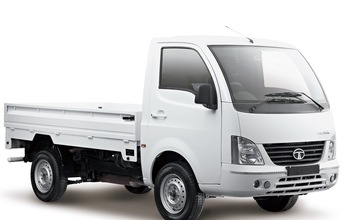
The SCV cargo segment <2T is a skewed two horse race. Tata Motors has been able to leverage its first mover advantage to the fullest extent and holds onto 78 percent market share in FY14.
Mahindra, relegated to a distant 2nd place with 17 percent market share, is however able to extend its traditional strength in SUVs to pickup trucks in the 2-3.5 T segment. Here, the Bolero Pickup and the Bolero Maxi Truck drive sales and are the mainstay of Mahindra's dominant market share of 64 percent.
The pickup segment has been growing strongly over the last few years aided by aggressive pricing. It currently accounts for about 54 percent of the segment and is likely to be hotly contested by all three major players, Mahindra, Tata and Ashok Leyland with its successful, albeit late, entrant Dost.
Interestingly, the 3-Wheeler cargo segment has managed to hold on to its volumes of 90-100 k units/year over the last five years despite stiff competition from SCVs. Price differentials of about 40 percent between the 3-Wheeler and entry level SCVs explain this resilience to a large extent. The 3-Wheeler segment itself has seen some interesting shifts, however, notably significant market share gains by Atul Auto, a rather late entrant in the segment.
SCV passenger carriers amount to about 191 k units in FY14, about 20 k units less than in FY11. Here, SCVs have not managed to displace 3-Wheelers (about 385 k units sold in FY14) due to cost issues, fuel efficiency differences and government regulations (most routes require permits).
Overall, a shift in customer preferences from hard top vans towards soft tops and MPVs is visible. This results in stagnant volumes in the SCV passenger carrier segment going forward.
According to a recent Roland Berger study, the SCV segment will continue to grow at a CAGR of 13 percent till 2020 and reach a staggering volume of 919 k units by then.
The bulk of this growth will be in the cargo segment driven by OEMs development of new applications, e.g., poultry, milk and water distribution, easily accessible finance and continuous focus on driver education and training. Nevertheless, profitability in the segment will be a concern in the short to mid-term due to relatively low capacity utilization and increasing competition.
OEMs that want to win in this space will have to continue to develop a keen understanding of evolving customer requirements (e.g., the shift from the 2T segment to higher tonnage pickups). Spotting and potentially even creating segment shifts will provide an excellent opportunity for profitable growth.
Liaising with local government authorities in order to promote SCV passenger carriers will be crucial as well as spreading the awareness around the benefits, applications, etc., of SCVs among potential customers. Development of new applications to expand the market (e.g., paint/ gas cylinder/ water distribution, waste disposal, etc.) will remain a key focus for growth.
Last but not least, OEMs will have to develop drivers for the segment as the majority of the end users belong to lower economic sections of society and will most likely be first time users of any kind of motorized vehicle.
Government needs to support the segment by investing in and promoting infrastructure projects such as Metro rail networks across various congested cities.
The permit issuance system for SCV passenger carriers should be streamlined to create an environment for healthy competition between SCV passenger carriers and 3-Wheelers. Especially in rural segments, schemes for cheaper financing options should be explored to promote the usage of SCVs and with it improve the connectivity of rural areas with urban centers.
The author is Managing Partner at Roland Berger Strategy Consultants, India.
END


























